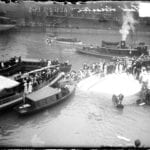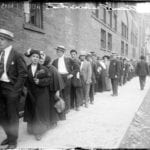the dark history of "harpo studios" overshadowed by its contemporary use as a tv studio
This entry was posted on August 1 2016 by Eric

a demolition that has recently drawn much media attention is underway on the near west side, where harpo studios will be razed to make way for a mcdonald’s corporate headquarters. the studio complex, which is often discussed of late in terms of its occupancy for the last two decades, has yet a longer and more storied history. overshadowed by its recent use for entertainment, the rubble and bricks of harpo studio tell a tale of one of the worst maritime disasters of the early 20th century.


this older era of life inside 1058 w. washington flickers on through ghost stories. the site is reputedly haunted by vestiges of its time as a temporary morgue, housing the bodies of those who perished during the eastland disaster.


in the summer of 1915 (just three years after the titanic had capsized), the western electric company chartered four ships to transport employees and their families to an annual company picnic in the dunes of indiana. at about 6:30 am on a rainy morning, the steamships were docked along the chicago river, ready to be boarded for a jovial event arranged for 7,000 people. unfortunately, the day would quite literally take a disastrous turn, when the eastland became unbalanced and toppled over, immediately after leaving its dock near the clark street bridge. within minutes after tipping, the vessel had entombed hundreds of passengers underwater, and many more who had been thrown overboard drowned amidst the chaos, overcome by the surging current, and the weight of heavy clothing. although the eastland rested in just 20 feet of water, over 800 people were killed during the nightmarish and preventable accident which wiped out 22 entire families. the cause was controversial and litigation took decades in court, but common consensus on record is that overcrowding exacerbated an already unsteady ship. there was negligence on the part of the company for not heeding warnings or making any effort to avert calamity, instead trying to fit an unsafe number of people onboard.


the rescue operation was swift but largely futile for those who had been trapped in the hull. roughly a quarter of the passengers perished, even as divers, firefighters and a large gathering crowd tirelessly worked to rescue those in the water. a witness to the event described, “I hope I never see anything like it again in my life... I have been as limp as a rag ever since. the horrible part of it was that the passengers didn’t seem to feel their danger until it was too late. they were just dumped into the river like a load of sand dumped from a wagon.” passerby described a sea of bodies clinging to debris in the brown water, some floating downstream, all amidst the sound of screaming that could be heard for blocks. even so, the spectacle was irresistible, and nearly 500,000 people arrived to view the scene, crowding bridges and the waterfront, while some boat owners even charged curious passengers to ferry past.

among the most emotional stories published in the days following, a city fireman named fred swigert worked for hours to lift bodies out of the hold, and unexpectedly found his own daughter among the corpses. sadly, a number of surviving employees also reported that western electric company had coerced them into going, selling them tickets to the excursion for 75 cents apiece, with the implicit threat that they would lose their jobs if they did not join.


the eastland capsized close in time to two similar disasters--just 3 years after the titanic, and 10 weeks after the lusitania had been torpedoed and sunk. in fact, post-titanic safety measures (regulating a larger number of lifeboats on board) may have contributed to the eastland's being top heavy, with unsafe weight distribution. though the eastland is dwarfed historically by the titanic, interesting perspective is provided by statistics-- three times as many people were killed in the eastland disaster as the great chicago fire, and it represents the largest loss of life in a single event in the u.s. during the 20th century. in the wake of the accident, hundreds of corpses were taken to the second regiment armory (at washington and curtis) which had originally been a cold storage warehouse and now became one of the largest morgues used that day. photographs surrounding the tragedy depict long lines of relatives streaming into the armory to identify bodies.


some charge that the eastland disaster is not well-remembered because it was working class immigrant families on board, with no famous or illustrious victims. in parallel, the role of the former armory has diminished through time, as it was transformed into a roller rink in the 1940's and a film studio in the 1950's (until oprah eventually bought the space for her enterprise in the 1980's). reports of ghostly activity, however, have continued to bolster interest in the history. now that the site is razed and material ties to the past severed, it stands to be seen how this sensationally tragic event will be commemorated or remembered.


This entry was posted in , Miscellaneous, Salvages, Bldg. 51, Events & Announcements, Featured Posts & Bldg. 51 Feed on August 1 2016 by Eric
WORDLWIDE SHIPPING
If required, please contact an Urban Remains sales associate.
NEW PRODUCTS DAILY
Check back daily as we are constantly adding new products.
PREMIUM SUPPORT
We're here to help answer any question. Contact us anytime!
SALES & PROMOTIONS
Join our newsletter to get the latest information













































